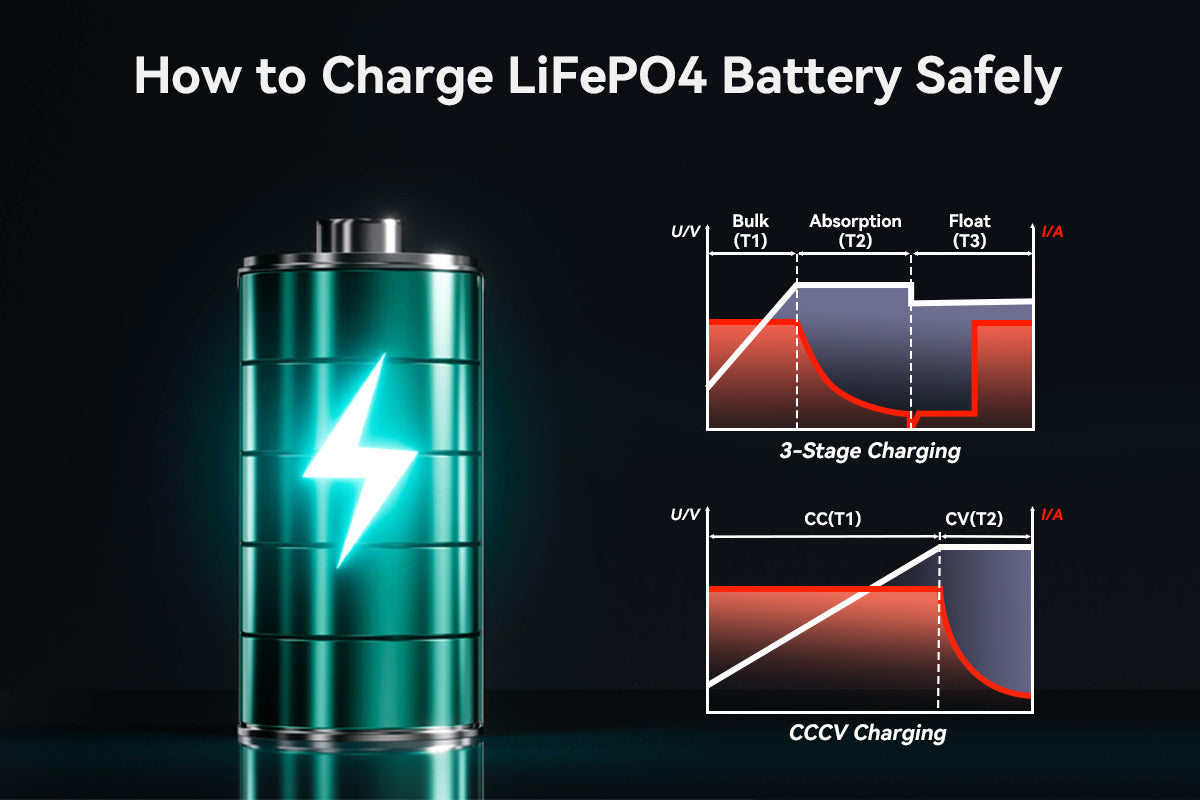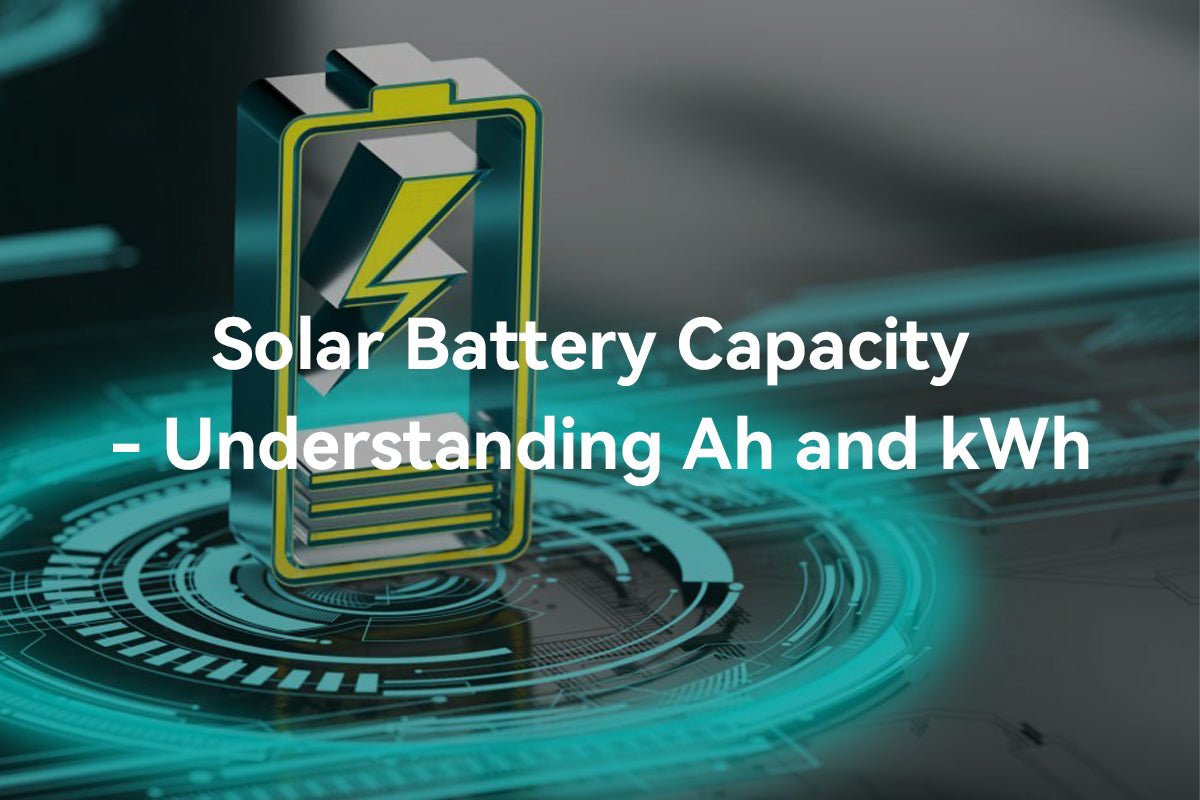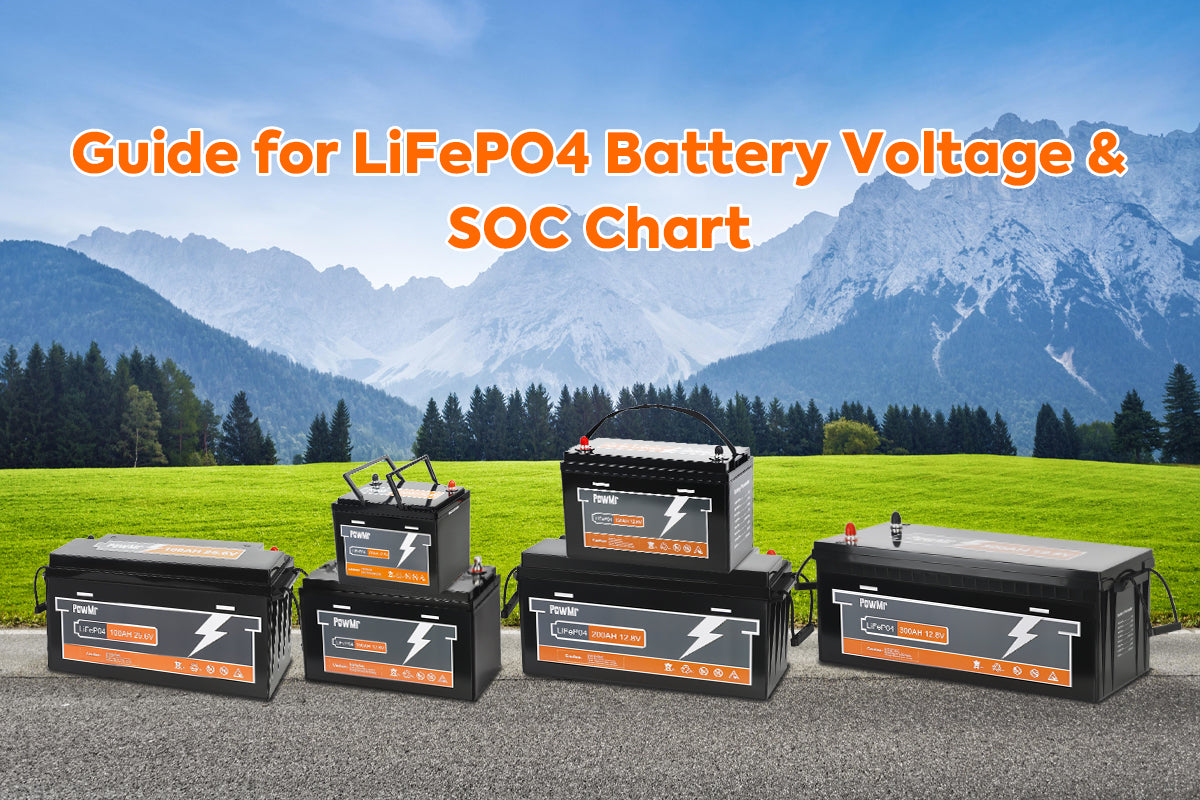Lithium Iron Phosphate (LiFePO4) batteries have gained popularity for their high energy density and long cycle life. To ensure the safety and optimal performance of LiFePO4 batteries, it is crucial to follow proper charging methods and guidelines.
This article examines charging methods, algorithms, recommended charging voltages for various battery systems at different charging stages, and safety tips for charging LiFePO4 batteries.
LiFePO4 charging methods
In this section, we delve into optimal LiFePO4 charging methods. Regardless of the chosen charging method—solar, AC power, or DC-DC—it's crucial to confirm compatibility between the selected charger and LiFePO4 batteries. This ensures optimal performance, longevity, and safety during the charging process.
Charge with solar energy
Incorporating solar energy for LiFePO4 battery charging is a sustainable and eco-friendly approach. Utilizing a solar charge controller, this method efficiently manages the energy generated by solar panels, regulating the charging process and ensuring optimal power transfer to LiFePO4 batteries. This application is ideal for off-grid setups, remote locations, and environmentally conscious energy solutions.
Charge with AC power source
Charging LiFePO4 batteries with an AC power source provides versatility and reliability. To optimize the charging of LiFePO4 batteries with an AC power source, hybrid inverter is recommended. This type of inverter, in addition to integrating a solar charge controller, includes an AC charger that can charge the battery from both generator and the electrical grid. This method is suitable for both on-grid and backup power systems, offering flexibility in charging options.
LiFePO4 charging algorithm
LiFePO4 battery use CCCV charging technique, its process consists of two stages: constant current charging (bulk charging) and constant voltage charging (absorption charging). This is similar to the first two charging stages of lead-acid batteries, with differences only in voltage parameters.

In the Constant Current (Bulk) Charging stage, the LiFePO4 battery charger delivers a specific current to the battery while gradually increasing the voltage to reach the bulk voltage. Both the charging current and bulk voltage are set by the user.
In the Constant Voltage (Absorption) Charging Stage, the charger gradually reduces the current while maintaining the targeted voltage. In essence, both the Bulk and Absorption stages aim to reach and hold the same target voltage.
Compared with lead-acid batteries, which have three charging stages and require full daily charging to prevent the sulfation of active materials, lithium iron phosphate batteries, due to their lower self-discharge rate, do not require trickle charging or float charging.
Float charge LiFePO4 or not?

However, in practical application scenarios, there is a frequently raised question: Float charge LiFePO4 or not? The answer is no. This confusion often stems from the fact that many charge controllers offer multiple options based on battery chemistry, like lead-acid batteries, which do require float charging. So it comes as no surprises that the charge controllers include an adjustable parameter related to this charging process.
If you can't disable the 'float charge' stage, you should set the float voltage lower. This adjustment helps prevent the battery's state of charge (SOC) from becoming too high, which could reduce the battery's lifespan.
LiFePO4 charging voltage chart
Understanding the charging methods of LiFePO4 batteries reveals that their bulk and absorption charging voltages are the same. Additionally, to ensure battery safety and longevity, LiFePO4 batteries have critical voltage parameters, namely Low Voltage Cutoff (the voltage at which the battery stops discharging) and High Voltage Cutoff (the voltage at which the battery stops charging).
These parameters are typically detailed in the battery's datasheet. You can also monitor and control the battery's charge and discharge levels by referring to the LiFePO4 SOC voltage chart within the allowed ranges.
For instance, for PowMr's 12V 100Ah LiFePO4 batteries, the charging voltage should be set between 10.8V and 14.6V. The Low Voltage Cutoff should be higher than 10.8V, and the High Voltage Cutoff should be lower than 14.6V. Similarly, for 24V batteries, the charging voltage should be set between 21.6V and 29.2V, with the Low Voltage Cutoff at 21.6V and the High Voltage Cutoff at 29.2V.
Also, it is crucial not to exceed the maximum charging current specified by the manufacturer, as this can affect battery performance and safety.
The charging parameters for LiFePO4 batteries can vary depending on the manufacturer. The table below shows the charging parameters for 3.2V, 12V, 24V, and 48V batteries.
| PARAMETER | 12V SYSTEM | 24V SYSTEM | 48V SYSTEM |
| Bulk Voltage | 14V – 14.6V | 28V – 29.2V | 56V – 58.4V |
| Absorption Voltage | 14V – 14.6V | 28V – 29.2V | 56V – 58.4V |
| Absorption Time | 0- 6 min | 0- 6 min | 0- 6 min |
| Float Voltage | 13.8V ± 0.2V | 27.6V ± 0.2V | 55.2V ± 0.2V |
| Low Voltage Cutoff | 10V | 20V | 40V |
| High Voltage Cutoff | 14.6 | 29.2V | 58.4V |
Tips for charging LiFePO4 safely
Tips for charging lifepo4 in parallel
- Ensure that the batteries are of the same brand, same battery types and with the same size.
- While associating LiFePO4 batteries in parallel, kindly ensure every battery is inside 0.1V of one another prior to placing them in assistance, This will limit the opportunity of awkwardness between batteries.
- Internal Resistance less than 0.05 Ω difference between any two cells/batteries. Make sure that all cables and connectors are of the same length and size to ensure the internal connections are of the same resistance.
- When charging batteries in parallel, the solar-derived charge current is divided by half, while the maximum charging capacity doubles. For instance, consider two 48V 100Ah batteries connected in parallel, each having a maximum charging current of 50A. In this configuration, the combined battery bank can be charged with a total current of up to 100A. This translates to an effective charging rate of 50A for each battery, assuming they have the same state of charge (SOC).
Tips for charging lifepo4 in serie
- Before series charging, make sure that the type, brand and capacity of each battery is the same, otherwise it will cause voltage imbalance between the batteries, resulting in overcharging or undercharging, affecting the performance and lifespan of the batteries.
- While interfacing batteries in series, kindly ensure every battery is inside 50mV (0.05V) of one another prior to placing them in assistance. This will limit the opportunity of an awkwardness between batteries. Assuming your batteries escape balance, the voltage of any battery is >50mV (0.05V) from one more battery in the set, you should charge every battery separately to rebalance.
Tips:
You can charge every battery separately intermittently to stay away from unevenness. While charging LiFePO4 batteries in series, it is ideal to utilize a multi charger/multiple mppt hybrid inverter that charges every battery exclusively to guarantee the cells stay adjusted. You can likewise utilize a 24V battery LiFePO4 charger or a 48V battery LiFePO4 charger assuming that you might want to charge your framework overall.
Whether You Can Charge the Battery Directly with a Solar Panel
It is not advisable charge battery diectly with solar panel, because the output voltage and current of solar panels will vary depending on the intensity and angle of sunlight, which may exceed the charging range of LiFePO4 batteries, resulting in overcharging or undercharging, affecting the performance and lifespan of the batteries.
Therefore, to safely use a solar panel to charge a LiFePO4 battery, you need to add a charge controller between the solar panel and the battery.
FAQS on charging LiFePO4
FAQS on charging LiFePO4
With minimal self-discharge, even a six month idle period will not drop the charge much. Therefore,It is advisable to recharge an LFP battery before it depletes to the 20% charging point (80% depth of discharge), to ensure the BMS functions correctly.
How many amps to charge LiFePO4 battery
The charging current for a LiFePO4 (Lithium Iron Phosphate) battery depends on its capacity and the manufacturer's specifications. Generally, it is recommended to charge a LiFePO4 battery with a current that is 0.5C to 1C, where C is the capacity of the battery in ampere-hours.
As mentioned above, in parallel charging scenarios, the maximum charging capacity is cumulative, and the solar-derived charging current is evenly distributed, resulting in a reduction of the charging rate for individual batteries. Therefore, it is imperative to make adjustments according to the quantity of batteries involved and the specific requirements for each battery.
Can I charge LiFePO4 with lead acid charger
whether we can utilize a lead-corrosive battery charger to charge LiFePO4. The short response is indeed, the same length as the voltage is set inside the boundaries OK for lithium iron phosphate batteries.
How long does it take to charge a LiFePO4 battery
LiFePO4 batteries typically support faster charging rates, and the charging time can range from a few hours to several hours, depending on the specific conditions, such as the battery's capacity, charge rate, and the charging method used.



